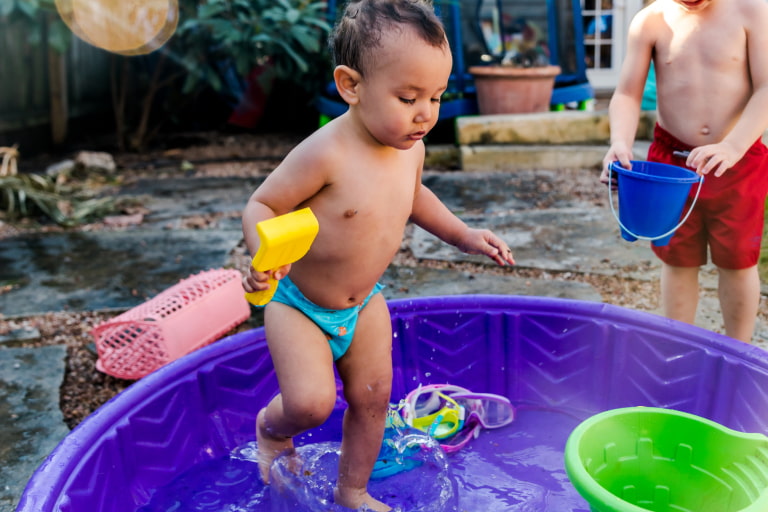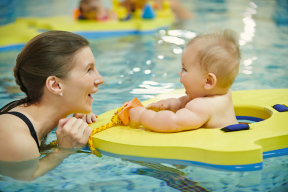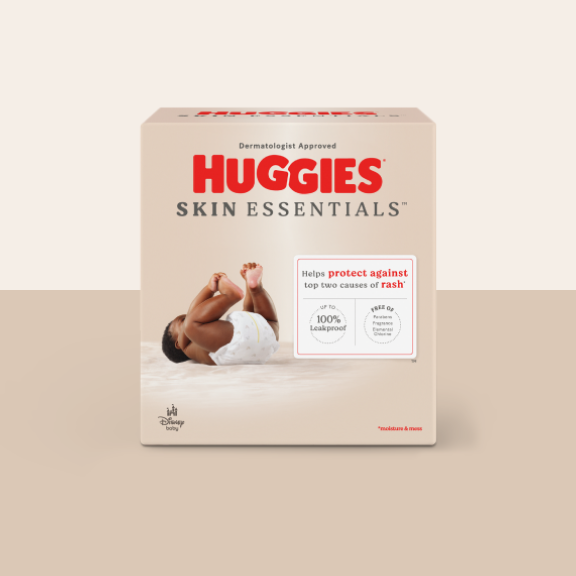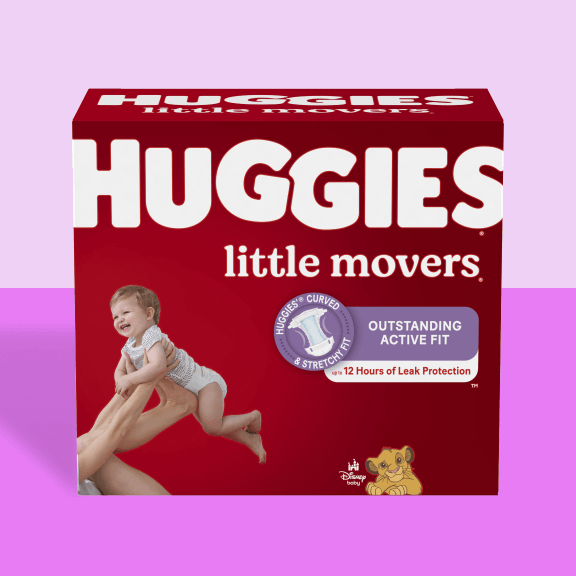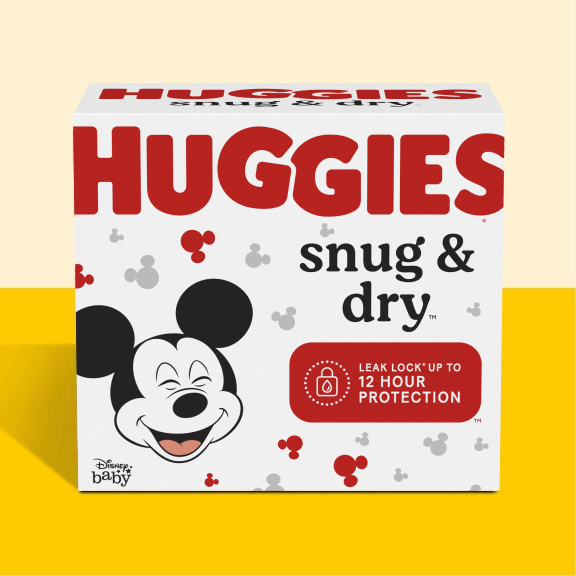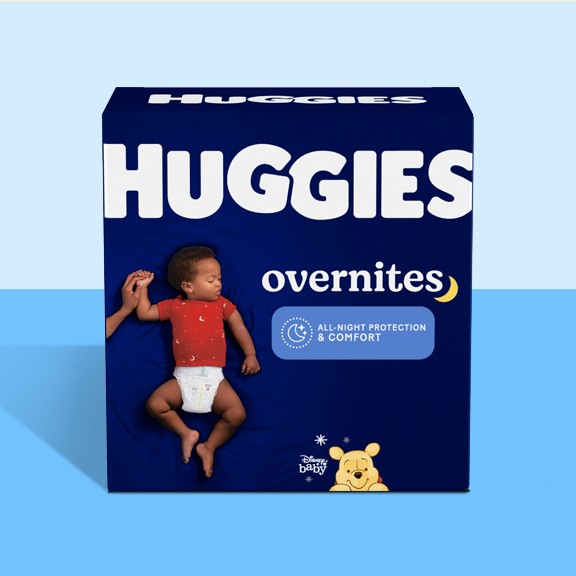4 benefits of swimming for baby
- Staying safe. One of the main reasons that many parents teach their infants to swim is safety. Teaching your baby the basic safety skills like jumping in, turning around, holding on, swimming back to the side and back floating could one day save his or her life. Of course, no matter how well your children can swim, it’s important to always keep any eye on them.
- Enhanced physical development. Swim movements help build strength, fitness, co-ordination and early muscle formation.
- Improved social and behavioral habits. Swimming stimulates your baby, while regulating his or her eating and sleeping patterns.
- Feeling Independent. Being almost weightless and able to move their arms and legs allows your child to enjoy a newfound sense of independence without any fear of falling down.
Swim diapers
A typical diaper would get quite large if worn in the pool, ocean or even in the sprinkler. HUGGIES® Little Swimmers®, offer dual leak-guards to help protect against floating embarrassments. Its comfortable stretchy side material ensures a great fit in or out of the water. You can even take Nemo, Dory, and Squirt from Disney®/Pixar’s Finding Nemo with you thanks to the diaper’s fun designs.
How to keep baby safe while swimming
- Check that the pool temperature is between 31.5 and 33°C. You can always call ahead and ask the pool staff to check for you.
- As soon as your toddler starts to shiver, make sure you get out of the pool and wrap them up warmly.
- Start off with swim sessions of 10 minutes and build up to 20 minutes. If your baby is under 12 months, avoid staying in the water for longer than half an hour.
- If your baby has sensitive skin, check with your doctor to make sure the chlorine won’t irritate it.
- If you have a pool at your house or your neighbors have pools, make sure it’s fully fenced with a latched gate and make sure the gate is securely locked at all times.
- Don’t leave any toys in the pool when you are done swimming as your child might be tempted to go in to get them.
- A healthy measure of sunscreen should be applied whenever taking your child for a swim. Your toddler’s skin is more sensitive to the sun and gets burned really easily.
- Learn CPR. It’s an invaluable first aid technique to possess, and you never know when you might need it.
Introducing your baby to the water
- Make bath time fun by gently splashing water over baby, or laying your baby on their back and slowly moving them through the water.
- When you first start going to the pool, make sure you go in the quietest part of the day to calm baby’s nerves.
- Keep eye contact with your baby, and hold him or her close to your body. As you and your baby feel more confident, you can extend your arms and move around in the water.
- Bring a bath toy to the pool to familiarize your baby to these new surroundings.
- Keep trips to the pool relatively short and time your trip between meals and well before naps.
- Think about bringing a floatation device but note that while they help keep your baby floating and get him or her comfortable with the water, they can give a false sense of security for you and your little one. So they should never be relied on as the sole safety measure in place around water.
- Let your child learn by example. Put your mouth underwater and blow bubbles. You can even practice this out of the water by blowing some bubbles and having your child blow them.
- Lay your baby on his or her back, with their head resting on your shoulder. Encourage your baby to kick their legs and make the biggest splash they can.
When to start baby swim lessons
Choosing a swimming class
Also look for a well-maintained pool and good facilities. Little ones tend to swallow some water, so it’s important that the water is clean and has the right level of chlorine.
Also, be sure to ask about rules regarding swim diapers. The last thing you want is for you little one to be swimming with waste. Check the temp of the pool water, too. For children 3 and younger, it should be heated to 87 to 94 degrees Fahrenheit to avoid hypothermia.
As for the lessons themselves, they shouldn’t actually focus on swimming per se, but more on the safety aspects of being in the pool, like getting acclimated to being in water and gaining confidence.
Different strokes for different folks
One of the first things to master is a strong kick. Gently guide your child to the side of the pool and get them to hold onto the ledge as you do the same thing. Then proceed to have a game by seeing who can splash the most while kicking. Repeat and practice as often as you can until your child gets the knack of kicking.
The front crawl (also known as freestyle) is among the easier of the swimming strokes. Get your tot to float on their tummy in the water. Have your little fishy try to propel themselves by rotating their arms in a windmill motion, and kicking their legs in a fluttering motion. Coordinating breathing with the stroke is pretty tough so it might be something that your toddler only grasps after some practice.
Backstroke is almost exactly like the crawl except you teach your child to do the stroke on their back. You’ll probably want to hold off on the backstroke, breaststroke and butterfly until your baby is a bit older.
Swimming games that teach
Swim like an alligator
Scatter sponges, balls and plastic toys that float on the water and pretend to be alligator chomping them up. Your baby will get used to the feeling of floating on their stomach and using their arms and legs to move. Baby not floating yet? Try kneeling in the pool and hold their waist to keep their head above the water.
Motorboat
Have baby place his or her face in the water and blow bubbles. If you senses some reluctantly first, lead by example. You can also move baby around in the water while encouraging them to kick.
To create a little more fun, sing the motorboat song ! “Motorboat, motorboat go so slow. Motorboat, motorboat go so fast. Motorboat, motorboat step on the gas.”
Hand Puppets
Turn an old sock into a frog puppet to encourage your toddler to kick and paddle in a circle as you sing this song to your own tune. “Kick, kick went the little green frog one day. Kick, kick, went the little green frog. Kick, kick went the little green frog one day and he kicked, kicked all day long.”
Kickboard boat
Pretend a kickboard is a boat and your child’s feet are the engine. Get your toddler and some friends to race their boats across the shallow baby pool and see which one crosses the finish line first.
If your little one needs a bit of help, keep their head above the water then hold them to one side around the waist. This will help with practicing kicking in the water and muscle coordination.
Little pancake
Lay your little one on their back and move them through the water making sure you are supporting their back. This will help your little swimmer develop balance while floating in the water.
Sing “I’m a little pancake on my back. I’m a little pancake nice and flat. I’m a little pancake on my back. Flip me over just like that.” This will encourage your little one to roll over and float on their tummy.
Little green frog
Position your baby on their side with you holding them for support. Encourage your baby to move his or her arms, then legs and blow bubbles.
Create more fun by singing, “Now we all know frogs go, la de da de da, la de da de da, la de da de da. They don’t go glumph, glumph, glumph!” This game teaches baby to float on their side and combines balance and movement.
If you’re happy and you know it, splash your hands!
Hold your baby at arms-length and sing, “If you’re happy and you know it splash your hands. If you’re happy and you know it splash your hands.
If you’re happy and you know it then you really ought to show it, if you’re happy and you know it kick your feet, wave goodbye!”
If you’re looking for more swim ideas, check out what inspired us at the Swimming Teacher .
Have a little swimmer on your hands? Check out our Little Swimmers Disposable Swim Pants.
